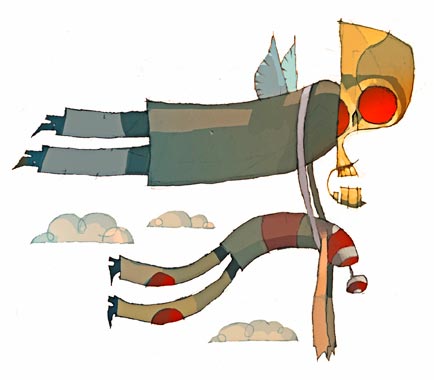Flirting with death
By: Saúl López Noriega
Source: Nexos
Man faces a problem with death, although not due to his biological dimension, that is, the physical process through which the body reaches the definitive point of its deterioration. Rather, the difficulty is that, unlike the rest of the animals, the human being is the only one aware of his finitude. Therefore, a common thread linking together humanity’s diverse attitudes concerning death is its impulse to hide and repress its consciousness that it will inevitably turn up. This is how Norbert Elias starts his work, The Loneliness of the Dying[i], a booklet whose brief length contrasts with the depth of his reflections.

And this German philosopher continues: but if hiding death is a trait present since the most primitive social organizations, what has been altered is the sort of illusion to disguise such knowledge; the collective fantasies seeking to digest the knowledge of our mortality: reincarnation, life in the afterlife, elixirs for immortality, and a very long etcetera expressed by a series of behaviors and perceptions that contribute to mold a society. Thus, the idea of death has been crucial in each stage of the human evolution.
In this context, Elias’s central thesis is that the strong civilizing thrust, which started in the Western part of the world 500 years ago, changed man’s attitude toward death. What’s more, it changed the very way of dying. In other times, the fact of dying was a more public matter, a social event. Proof of this is that contemplation and contact with corpses was much more routine. As people died in their homes, relatives, friends, neighbors (including children) had the opportunity to live with the dead and know the ups and downs of the decomposition process. But this is no longer the case. Never as nowadays have the sick and the dead disappeared from the sight of the living, to the extent of hiding them behind the stage of social life and sending them to the private setting. Never before corpses had been transported with such hygiene and technical perfection, not from their home, but from a hospital to the grave.
Elias concedes that, indeed, there are good public health reasons for this turnaround. But although in the past people used to die with less asepsis, on the other hand they were provided more human warmth. Today, preparing the corpses for their funeral and performing their burial has passed from the hands of relatives and friends to professionals who charge for doing such tasks, and thus they deal with hundreds of corpses throughout the year. Likewise, the vocabulary to talk about terminal illnesses or death itself has deteriorated, unable to express the feelings typical of such situations and, at the same time, is packed with euphemisms that hinder a better interaction with this inexorable event. The current expressions and social ups and downs, absurdly baroque and solemn, are just a symptom of the semi-unconscious effort of the living to distance themselves from the dead. Such is our prevailing illusion: to hide that intrinsic aspect of the human being that has become intolerable for our normal life: death.
But isolating those dying or those already dead is part of a phenomenon that has affected a wide variety of ingredients of the social soup: individualism. Indeed, the freedom share that we have gained by diluting the image of society as an organism where each of us is nothing more than a gear of a superior machinery, we have lost it by becoming unable to accept ourselves as part of a chain of human links. The idea that at death we are alone is consistent, in the last analysis, with the modern times emphasis received by the perception that we are alone during life itself. And there is precisely where we should begin to rescue the dead … and us, the living.
Nevertheless, some people consider that the idea of the dead solitude is not entirely accurate. Claudio Lomnitz, for example, states that while this reflection is accurate on several issues, it is also true that its reach does not go beyond the United States and Europe; that is, it cannot be extrapolated to the whole West and much less to a country like Mexico, unable to be compared with any other nation regarding its way of relating to death. Such is precisely the central idea of the book written by this anthropologist of Chilean origin, The idea of death in Mexico[i], an investigation supported by the best academic discipline, which elegantly avoids the stiffness of the university monastery to present a really creative social, cultural and political history of death in a country that has adopted as its defining symbol.
Indeed, Lomnitz considers that Mexico’s adoption of death as its national symbol is at odds with other somehow peculiar models such as that of the fascist Japan, the revolutionary Iran or the contemporary Palestine, where its relationship with death is aimed towards a project of imperialist expansion, of national liberation or a religious sacrifice. In the case of Mexico, on the contrary, it is a popular characteristic that unfolds in everyday life, in addition to being the result of a vigorous cultural miscegenation where the indigenous and popular element integrated and transformed the colonizer’s culture. And this is because the dead, as well as the representation of death and of the next world, had such dominance that they were crucial to the formation of the Mexican State.
Lomnitz’ study begins with the conquest of America by the Spaniards and the overwhelming process of colonization they faced, never before attempted on such a scale by a European society since the Roman era, which required them to snatch the power over life of the native inhabitants of this land; to define, in factual terms, who lived and who did not; and what all of this implied: mutilations, rapes and dismemberments, among other excessive expressions of violence. But this is not entirely alien to any group seeking to establish control over a given territory. Therefore, what is really peculiar is that, as they lacked an adequate set of resources to establish an order in front of a population that far exceeded them numerically in such a large and rough territory, the colonizers were compelled to devise a representation of death that could blend with the entrenched pre-Hispanic customs and take advantage of the most basic motivations of the human being, with the purpose of establishing the minimum and indispensable institutional substrate to build up a social order.
Thus, in response to the genocide that characterized the early years after the arrival of the Spaniards, at the time of the Colony a process for managing death, funerals, corpses and burials began. The scope of this text falls short to justly convey the fruitful analysis offered by this Columbia University professor. It is worth emphasizing, as an example, the orchestrated strategy between the Catholic Church and the Spanish monarchy to establish a minimum set of rules both for the indigenous, to abolish their traditions of human sacrifices and cannibalism, and for the conquerors to hold back their excess of violence. A key point of this project was to highlight the idea of purgatory in such a way as to establish a strong bridge between the living and the dead. This in turn allowed to strengthen the clergy’s alliances with the population by introducing a truly valuable exchange currency: their future and that of their loved ones once they died. With this were also laid the foundations for consolidating a new colonial economic policy by placing the death at the center of the tributes, the testaments and other institutions.

Then, Lomnitz starts to sunder the crucial point of his idea, addressing aspects such as the funeral prayers and the emergence of political criticism; the confrontation between liberals and the Catholic Church that, among others, had as a battlefield precisely the bureaucracy of death; the heroic corpses of independence and revolution champions as an input of the hegemonic political speech of the Institutional Revolutionary Party during most of the twentieth century; finally, he reaches our present days in which even the weakness of the State has prompted the emergence of figures such as the Holy Death, which has become a symbol bringing order and peace to segments of society who face new uncertainties.
Now, an important aspect that revolves around death is the handling of corpses; the way they are buried; the ultimate destiny that each society gives to their dead according to their illusions and traditions. In this sense, throughout history religion has defined the relationship between man and his corpses. However, the fissure caused by the Enlightenment and the growing prominence of science in the religious cuirass, secularized various aspects of social life and opened spaces for new ways of handling the dead in contemporary societies. This is just the research that guides Mary Roach’s book, Stiff. The curious lives of human cadavers[i] What fate do human beings have once they die and become corpses?
A good starting point to delve into this puzzling subject is the proliferation of medical schools in Europe during the eighteenth and nineteenth centuries, which caused a no minor problem: let these new students have access to corpses so that they could learn their lessons. The practice, at the time, was to dissect the bodies of the executed criminals, but the increase in demand for corpses made this custom obsolete. Soon a new business line emerged: the theft of corpses from their graves.
Such practice caused the black market for corpses to become a profitable business. The scarcity of this anatomy studying material was such that at several universities the tuition ceased to be determined in ready money but rather in reference to corpses. This need still exits to this day in medical schools where corpses are greatly appreciated, or, in certain cases, some of its parts. Indeed, given the difficulty of getting whole corpses, and considering the purpose of the anatomy practice, all parts of the human body are used. In fact, one of the most impressive photographs in this book shows dozens of human heads lined up on work tables where California plastic surgery students improve their face-stretching technique.
But in addition to the current traditional medical use of corpses, this American journalist describes no less interesting cases. Today, for example, the automotive industry uses corpses for accident simulations they have to perform to improve their cars safety. It is true: several of these rehearsals are performed with mannequins equipped with sensors designed for this task. However, to achieve greater accuracy it is necessary to use human flesh that clearly reflects the advantages or flaws of the new design of airbags, safety belts and bars, etc.
In that same vein, human bodies are also used to test the effect of prototype weapons. Yes, several armed forces around the world use corpses or parts of them to find out, as accurately as possible, what damage their new models of bullets, grenades and mines cause to our bodies. It is worth mentioning that, on many occasions, the purpose of such tests is to determine whether certain weaponry should be prohibited according to international war rules. Another example: inert human bodies are also used as practice material in forensic schools. Such is the case of the University of Tennessee Medical Center that takes advantage of the corpses it receives as donations to randomly place them in a forest that is part of the college facilities. The challenge for students is to locate the bodies and, irrespective of their degree of decomposition, determine the cause and time of death.
At this point, it is not difficult to imagine that one of the trickiest aspects of using corpses is where to draw the ethical line between what can or must not be done with them. The problem is exacerbated because in most countries, where a corpse can be donated for scientific purposes, the donor cannot stipulate that type of use. That is, once someone donates his/her body, it may end up in the hands of a heart surgeon or as a target for some gun manufacturer. The truth is that, based on several interviews Roach held with doctors, technicians and scientists, several fields of knowledge might be improved if we were able to do something that seems almost impossible, that is, to consider corpses as what they really are: a bunch of meat with no connection with the person it once was.
But in addition to the philosophical, historical and journalistic view, it is important not to forget that death can also be observed from the balcony of science. Right: for many years, science saw death as the end point: the line separating existence from rotten meat. What was relevant in scientific terms were those phenomena prior to death. When studying life by definition, biology could not deal with death.
However, this conception collapsed when a group of biologists discovered genes whose primary function is to instruct the cell how to build the molecular weapons necessary to commit suicide. It is a set of instructions to perform a programmed suicide. That group found genes responsible for killing groups of cells in a specific way. Such discovery won the Nobel Prize in Medicine in 2002, and Marcelino Cereijido and Fanny Blanck explain it in a very interesting essay, emblematic of what scientific dissemination should be: Death and its advantages.[ii]
The task of these so-called genes of death is not something accidental as the death of cells caused by a hammering in the finger or a burn in the belly. It is, rather, a task that is performed constantly inside the body and with very precise objectives: A cellular death programmed to eliminate those cells that have already fulfilled their mission in our body. In fact, there are cells that at some stage of their life cycle cease being helpful for the development of the whole organism and, therefore, receive the order to commit suicide and leave their space and resources for the new generations. This happens, for example, when baby teeth are replaced by the definitive ones, or when our fingers are formed from a hand stump during pregnancy.
But the genes of death have also the mission of correcting errors of our organism; thus, when a cell disconnects itself from its neighbors, it stops receiving the information about the rest of the organism that everything is fine, or it simply begins to carry out other cells’ functions; if that’s the case, its corresponding genes of death get activated again and, following their instructions, it sacrifices itself. Thus, when those genes remove the expired and defective cells, their ultimate objective is the harmonious development of the organism. At the time, this discovery prompted the idea that, if those genes could be controlled, the secret of immortality would be revealed. However, the result of inhibiting its operation through sophisticated experiments did not result in eternal youth, but rather in a monstrosity: the reproduction of cells without any control and the presence of tumors. Hence the importance of the genes of death to keep our organism functioning properly: without them there would be no life.
In this context, science has only begun to investigate a very complex seam of knowledge that opens up a wide range of possibilities. Without going any further: behind cancer—as well as neurodegenerative and autoimmune diseases such as type 1 diabetes—lies a malfunction of the genes of death which either allows an undue proliferation of certain groups of cells or forgets to eradicate those that have already completed their task or are beginning to perform a wrong task within the ambitious cellular project. In this way, probably the most exciting part of this discovery is the shift in the biological notion of death. Studying life requires to poke around the mechanisms of death and what this implies: ironically, life is unthinkable without the help of death.
Saúl López Noriega
Full-time professor-researcher, ITAM Law Department.
Source: Nexos
https://www.nexos.com.mx/?p=23051

